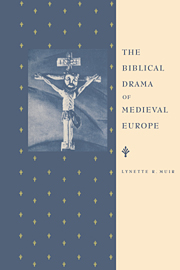Book contents
- Frontmatter
- Contents
- List of illustrations
- Preface
- Acknowledgements
- List of abbreviations
- Map 1 Medieval Europe showing locations of principal play-texts and records cited in this study
- Map 2 Enlargement of central area showing locations of liturgical and feast-day plays as defined in chapter 1
- Map 3 Enlargement of central area showing locations of civic and community plays as defined in chapter 2
- Introduction: Christian Europe and the Play of God
- PART ONE THE THEATRICAL COMMUNITY
- 1 Liturgical and feast-day drama
- 2 Civic and community drama
- 3 Performance and the community
- PART TWO THE THEATRICAL TEXT
- Conclusion: survival and revival
- Appendix: the liturgical context of the plays
- Notes
- Bibliographical index of plays
- Performance records and references
- General bibliography
- Index
1 - Liturgical and feast-day drama
Published online by Cambridge University Press: 18 September 2009
- Frontmatter
- Contents
- List of illustrations
- Preface
- Acknowledgements
- List of abbreviations
- Map 1 Medieval Europe showing locations of principal play-texts and records cited in this study
- Map 2 Enlargement of central area showing locations of liturgical and feast-day plays as defined in chapter 1
- Map 3 Enlargement of central area showing locations of civic and community plays as defined in chapter 2
- Introduction: Christian Europe and the Play of God
- PART ONE THE THEATRICAL COMMUNITY
- 1 Liturgical and feast-day drama
- 2 Civic and community drama
- 3 Performance and the community
- PART TWO THE THEATRICAL TEXT
- Conclusion: survival and revival
- Appendix: the liturgical context of the plays
- Notes
- Bibliographical index of plays
- Performance records and references
- General bibliography
- Index
Summary
FROM LITURGY TO DRAMA
As indicated in the previous chapter, the first biblical plays developed within the liturgical office of the monasteries founded by St Benedict, first of all in Italy but soon spreading throughout Catholic Europe. The Benedictine Office was sung not spoken and a variety of chants were used in the different parts of Europe, for there was considerable flexibility even within the Benedictine order. This was inevitable at a period when communication was difficult, and the influence of local cultures helped to encourage variations within local liturgies.
A dominant variant was the so-called Gallican liturgy in the Western Frankish empire (France), noted for its predilection for variety and ornamentation in the Daily Office. In the ninth century the Emperor Charlemagne tried to reform the Church in Gaul and insisted on the reintroduction of the Roman rite as revised by Pope Gregory the Great in the previous century. Part of Gregory's reform involved a simplification of the music which in many religious houses had become extremely elaborate. But although the music returned to the simpler mode laid down by Gregory and Charlemagne, it was the turn of the texts to be embroidered. Additional sections of narrative or dialogue were introduced into the liturgy of the major feasts, especially at Easter.
- Type
- Chapter
- Information
- The Biblical Drama of Medieval Europe , pp. 13 - 27Publisher: Cambridge University PressPrint publication year: 1995



